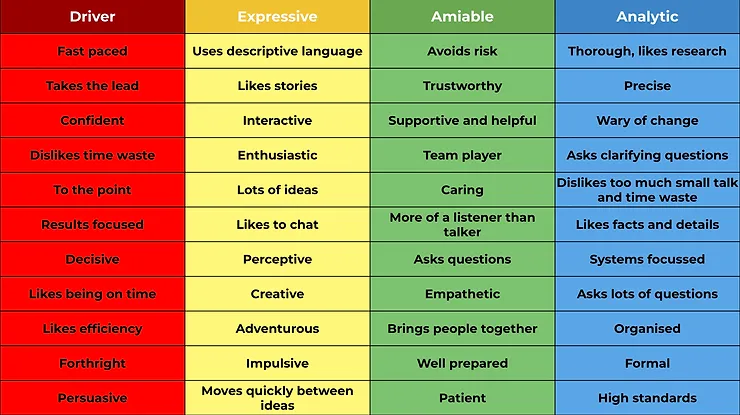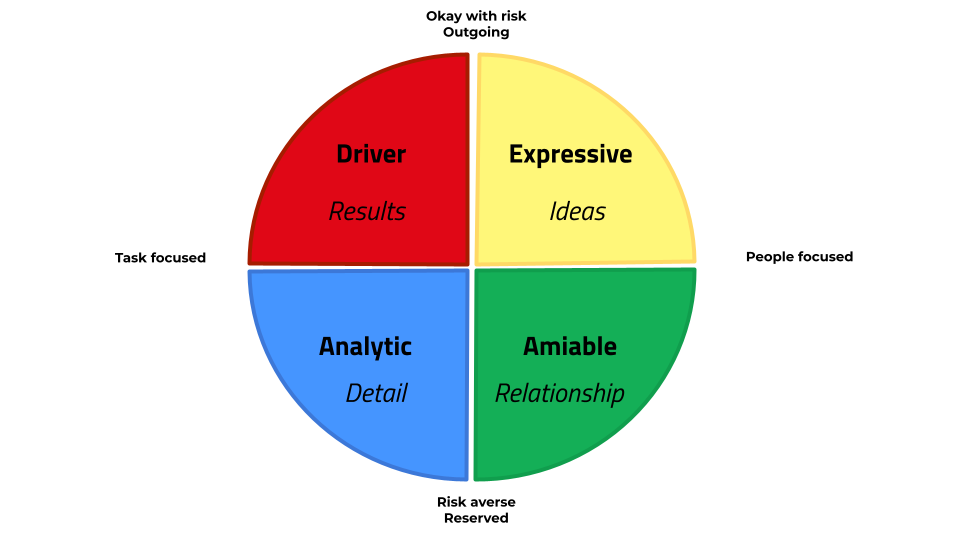25th August, 2021 • 3 min

Written by Em Roberts
6th March, 2023 •

We are taught as children to “treat others as we want to be treated”. What is missed out of the learning with this lesson is the big problem with it… Does everyone want to be treated as we want to be treated?
When it comes to skilful communication, it is much more effective to treat people how they want to be treated.
Just as each of us has our own unique preferences for where we like to go on holiday, the books we love, and the food we enjoy for lunch (for me it’s a falafel wrap) – we each have a unique preference for how we like to communicate.
The better we can identify and adapt to the four behavioural styles, the better we can adapt to each person’s unique communication preference.
Are you doing it already? Well ask yourself this… Do you send the same style of email to everyone you work with? Do you always take the same approach to building rapport in meetings? Do you begin all of your phone calls the same way? If the answer to any of these questions is yes, the truth is you are not adapting.
Here’s how you can use the styles as a tool to adapt to the communication preference of your team, clients, family and friends.
What are the four behavioural styles?
Read through these words, and choose the colour you identify with the most.

These four columns map onto four different behavioural styles. These styles hold the key to skilful communication.
The colour you picked is a very basic indication of which style you associate with. To find out which style you portray to others, it can be helpful to ask your team and those around you to read through the same columns and identify which colour they think best describes you.
Three important things to note about the styles:
The overarching characteristics of each can be considered together using this diagram.

How do you identify and adapt to each style?
Driver
Identify
Our red drivers are confident, fast paced and direct. They make decisions quickly and dislike time waste. They can inspire, think about the big picture and are not afraid to challenge to get to the best outcome.
In a meeting, our driver would be the one pushing the meeting forward, in control, keen to set actions and to clearly see how the results of the meeting are going to add value.
Adapt
Be clear and direct when communicating with a driver. Focus on outcomes and solutions rather than coming with problems. Let them drive the conversation forward. And be ready to challenge them when it’s going to benefit the bigger picture and earn their respect.
One of the biggest mistakes we often make with driver types is assuming because they are so action focused, they don’t want to build a relationship. With the driver, it’s not about whether they want to build a relationship, it’s about when. At the start of the meeting? Not usually the best time. However after you have wrapped up business or on the walk back from the meeting room to the lift are great moments to slot in your relationship building with a driver.
Expressive
Identify
Our yellow expressives share their enthusiasm with others – they are energetic. They often generate lots of ideas and like stories. They like to talk things through rather than read lengthy reports.
In a meeting, our expressive would be the one who would start by telling an interesting story, be the first to discuss and share lots of ideas, give longer responses to your questions, and are generally optimistic about any potential outcomes and possibilities.
Adapt
We want to show expressives interest and mirror their enthusiasm. To persuade them, you want to share examples or diagrams with an expressive rather than lots of details and facts. Ask them for their ideas on how they might approach problems to hear some creative solutions. Share them back with clear action points and a plan going forward.
Since they are visionaries, they particularly like knowing the ‘why’ behind what you are sharing, rather than how you are going to achieve it. By knowing this, they can evaluate whether their ideas may or may not be the right fit. A mistake we can make with the yellow is dismissing their ideas too quickly, so take the time to celebrate their desire for collaboration and idea generation before critiquing them.
Amiable
Identify
Our green amiables are excellent team players. They are empathetic, relationship focused, supportive and are adept listeners. They like consistency and stability.
In a meeting, amiables ask great questions, show a genuine interest in others’ ideas, are incredibly patient, and make sure everyone is comfortable with their role in the meeting.
Adapt
Often, as they are such great listeners, we can end up doing a lot of talking and not focusing on the amiable type enough. It’s important to ask them questions, encourage their ideas, show them you care about them by remembering details from conversations and ask for their help.
One of the mistakes we can make with an amiable person is thinking that they are comfortable with a new idea, change, or decision because they haven’t said otherwise. Make time to ask them what they really think and give them time to make decisions – as they will be careful to consider all possible outcomes.
Analytic
Identify
Our blue analytic is detail and fact orientated. They like structure, will take time over decisions, are systematic as well as thorough and precise. They consider their actions really carefully.
In a meeting, the analytic type would be the one keen to understand the evidence behind what you’re saying, asking you questions to help them understand further, studying the facts and figures and following the meeting agenda.
Adapt
To communicate effectively with analytics we want to demonstrate that we are prepared, by sharing resources, data, and research. When writing to them, use structure and bullet points to convey your message. Since they are risk averse, it can be wise to give them time to make a decision they are confident with.
One of the risks we can make with the analytic is not giving them time to think. So share your agenda before a meeting or in a conversation, and leave pauses for thinking time.
Key takeaway
Identifying the dominant four behavioural styles in your team and clients will allow you to communicate them in the way that they like and create excellent working relationships.
Give it a try, and if you or your team are interested in learning more about how we can use the four behavioural styles to collaborate and work with clients even more effectively, please get in touch.